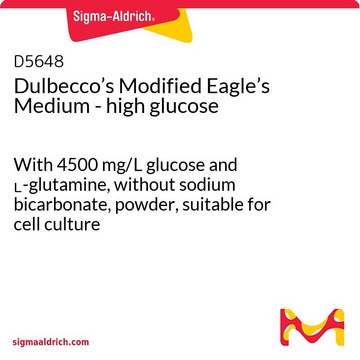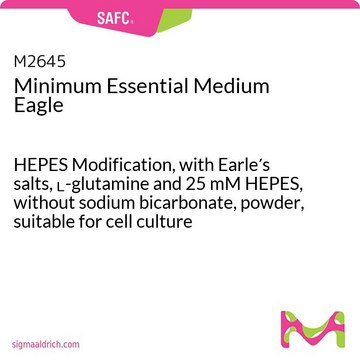D1152
Dulbecco′s Modified Eagle′s Medium - high glucose
HEPES Modification, With 4500 mg/L glucose, L-glutamine, and 25 mM HEPES, without sodium bicarbonate and pyruvate, powder, suitable for cell culture
Synonym(s):
DME, DMEM
About This Item
Recommended Products
Quality Level
form
powder
technique(s)
cell culture | mammalian: suitable
components
sodium pyruvate: no
NaHCO3: no
phenol red: yes
HEPES: 25 mM
L-glutamine: yes
glucose: high
shipped in
ambient
storage temp.
2-8°C
Looking for similar products? Visit Product Comparison Guide
Application
Quantity
Reconstitution
also commonly purchased with this product
supplement
Storage Class Code
11 - Combustible Solids
WGK
WGK 1
Flash Point(F)
Not applicable
Flash Point(C)
Not applicable
Regulatory Listings
Regulatory Listings are mainly provided for chemical products. Only limited information can be provided here for non-chemical products. No entry means none of the components are listed. It is the user’s obligation to ensure the safe and legal use of the product.
ISHL Indicated Name
Substances Subject to be Indicated Names
ISHL Notified Names
Substances Subject to be Notified Names
JAN Code
D1152-BULK:
D1152-10X1L:
D1152-PROC:
D1152LF1-BIBC:
D1152-VAR:
D1152-BIBC:
D1152-25KG:
D1152-50L:
D1152-1L:
D1152-2X5L:
D1152-50K:
D1152-25K:
D1152-50KG:
D1152-10L:
Choose from one of the most recent versions:
Already Own This Product?
Find documentation for the products that you have recently purchased in the Document Library.
Customers Also Viewed
Our team of scientists has experience in all areas of research including Life Science, Material Science, Chemical Synthesis, Chromatography, Analytical and many others.
Contact Technical Service






